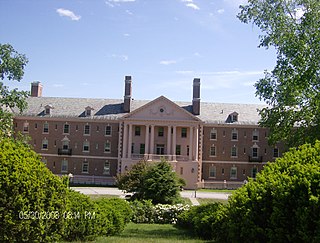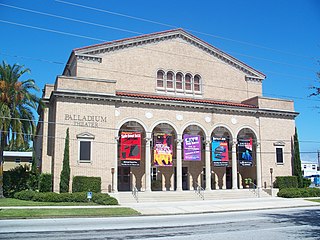
First Church of Christ, Scientist, also known as First Christian Science Church Edifice, is a church building located in Oconto, Wisconsin. Built in 1886 of stone, weatherboard and brick in the Gothic Revival style, it was the first purpose-built Christian Science church edifice in the world. It was added to the National Register of Historic Places in 1974.

The former First Church of Christ, Scientist, located at 614-620 15th Street, East, in the residential neighborhood of Elliott Park, in Minneapolis, Minnesota, United States. was the first Christian Science church building in Minnesota. It was once surrounded by Victorian homes, but most of them have been replaced by apartment buildings. Minneapolis architect S. J. Bowler designed the building in the Doric order. The facade of the building features a deep portico with two fluted columns holding up a pedimented gable.

The former First Church of Christ, Scientist, now the Little Rock Community Church, is a historic church building at 2000 South Louisiana Street in Little Rock, Arkansas. It is a single-story Mission style building, designed by noted Arkansas architect John Parks Almand and completed in 1919. Characteristics of the Mission style include the low-pitch tile hip roof, overhanging eaves with exposed rafter ends, and smooth plaster walls. The building also has modest Classical features, found in pilaster capitals and medallions of plaster and terra cotta. The building is local significant for its architecture. It was built for the local Christian Science congregation, which in 1950 sold it to an Evangelical Methodist congregation. That congregation has since severed its association with the Evangelical Methodist movement, and is now known as the Little Rock Community Church.

Red Rock Center for the Arts is a historic structure located at 222 East Blue Earth Avenue, in Fairmont, Minnesota, United States. It was added to the National Register of Historic Places on May 18, 1988 as the First Church of Christ, Scientist. It is now owned by Martin County, which leases it to the Martin County Preservation Association.

First Church of Christ, Scientist was a Prairie School church building located at 412 West Main Street, in Marshalltown, Iowa, United States. Designed by architect, Hugh M.G. Garden, it was once on the National Register of Historic Places, but was bulldozed in August, 1985, and was later removed from the National Register.

The Pleasant View Home is an historic senior citizen residential facility located at 227 Pleasant Street in Concord, New Hampshire, in the United States. On September 19, 1984, it was added to the National Register of Historic Places.

Iglesia La Luz del Mundo is a historic church located in Salt Lake City, Utah, United States. Originally built as the First Church of Christ, Scientist, on July 30, 1976 it was added to the National Register of Historic Places.

The former First Church of Christ, Scientist in Forest Grove, Oregon, United States, is a historic Christian Science church built in 1916. It was designed by Spencer S. Beman, son of the noted designer of Christian Science churches, Solon Spencer Beman who had died in 1914. On January 21, 1994, it was added to the National Register of Historic Places.

The former First Church of Christ, Scientist, built in 1940, is an historic Christian Science church building located at 391 Walnut Street on the corner of Otis Street in the village of Newtonville, in Newton, Massachusetts. It was designed in the redbrick Colonial Revival style by Densmore, LeClear and Robbins, architects. Due to cost constraints, its steeple was added later. In September, 2004, the church sold its building for $1,050,000 to be converted into apartments. The church in 2007 held services in rented rooms at 300 Walnut Street in the Masonic Building., but is now meeting at 1141 Walnut Street, in Newton Highlands. The building has since been divided into 11 condominium units. It is now called the Oxford House, and was the city's first inclusionary zoning project.

First Church of Christ, Scientist, built in 1907, is an historic Christian Science church building located at 406-408 Middle Street, in New Bern, Craven County, North Carolina, in the United States. It was designed in the Classical Revival style by prolific local architect Herbert Woodley Simpson.

First Church of Christ, Scientist is the main congregation for Atlanta, Georgia’s Christian Science community. Its historic Greek revival church edifice is located on the corner of Fifteenth Street, N.E., and Peachtree Street in the city's Midtown section and is a contributing property in the Ansley Park Historic District.

The former First Church of Christ, Scientist, built in 1912, is a historic Christian Science church edifice located at 1366 South Alvarado Street in Pico-Union, Los Angeles, California.

The former First Church of Christ, Scientist, built in 1916 in the Classical Revival style, is a historic Christian Science church edifice located at 132 E. 4th Street in Neillsville, Wisconsin. It was designed in the form of a Greek cross by Chicago architect L. J. Corbey for Christian Science Society, Neillsville, which had been organized in January, 1912 and which later became First Church of Christ, Scientist. Its front portico is supported by four large Tuscan columns. While small in size, the building projects a large presence. Its auditorium windows are of green opalescent art glass. On March 31, 2003, it was added to the National Register of Historic Places.

The former First Church of Christ Scientist, is an historic Christian Science church building located at 315 Wisconsin Avenue, Madison, Wisconsin, United States. Built in 1929, it was designed in the Classical Revival-style by noted Madison architect Frank M. Riley. In 1982 the building was added to the National Register of Historic Places.

The Palladium at St. Petersburg College, formerly the First Church of Christ, Scientist, is an historic Christian Science church building located at 253 Fifth Avenue North, in the Old Northeast neighborhood of St. Petersburg, Florida. Built in 1925, it was designed as a basilican structure in the Romanesque Revival style of architecture by architect Howard Lovewell Cheney. Cheney used Filippo Brunelleschi's 15th century Ospedale degli Innocenti in Florence as his inspiration. The builder was the George A. Fuller Construction Company of New York City, then one of the nation's leading builders.

First Church of Christ, Scientist, is an historic Christian Science church edifice located at 475 North Kingshighway Boulevard, corner of Westminster Place, in St. Louis, Missouri. Built in 1903–1904, it was designed as a stone building in the Classical Revival style of architecture by Edward Gordon Garden of Mauran, Russell and Garden and was the first institutional commission of that fledgling firm. Cost concerns, though, resulted in it being built of brick. It is a contributing property in the Holy Corners Historic District which was added to the National Register of Historic Places on December 29, 1975.

The former First Church of Christ, Scientist, built in 1907, is an historic Christian Science church edifice located at 1443–1451 North Prospect Avenue in Milwaukee, Wisconsin. It was designed in the Classical Revival style by noted Chicago architect Solon Spencer Beman, who designed at least a dozen other Christian Science churches across the country. On March 8, 1989, it was added to the National Register of Historic Places. Today it is occupied by 1451 Renaissance Place and is the venue for weddings and other social events as well as corporate events.

The former Sixth Church of Christ, Scientist, built in 1902, is an historic Christian Science church edifice located at 1036 North Van Buren Street in Milwaukee, Wisconsin. In 1980 the building was added to the National Register of Historic Places. On May 17, 1983, Sixth Church was made a locally designated historic site by the city of Milwaukee.

The First United Methodist Church is a Methodist church that was founded in 1868 in Reno, Nevada. In 1868 the first meetings were held in the local schoolhouse on the corner of what is now First and Sierra Streets. In 1871 The first church was erected and dedicated on Sierra Street between First and Second Streets. In the early 1900s the wood-framed church was moved to the back of the lot and a new brick building was added to it. And finally in 1925 plans for a new building were made. Designed by Wythe, Blaken, and Olson of Oakland, the church is one of the first poured concrete buildings in Reno and utilizes Gothic Revival architectural themes. The corner stone for the current historical building was placed in 1926, with the building being dedicated in December of that same year. It was listed on the National Register of Historic Places in 1983; the listing included two contributing buildings. The second building is a parish house designed by local architect Donald Parsons and built in c.1840. In 1965 another addition was done to add on what is currently the fellowship hall, and Sunday school class rooms.





















